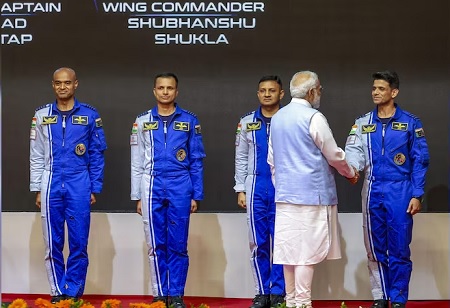
PM Modi introduces four Astronauts for India's Gaganyaan Mission

 Prime Minister Narendra Modi has announced Group Captain Prasanth Balakrishnan Nair, Group Captain Ajit Krishnan, Group Captain Angad Pratap, and Wing Commander Shubhanshu Shukla as India's astronauts-designate for Gaganyaan, the country's inaugural crewed space mission. These four officers from the Indian Air Force boast significant backgrounds as test pilots and are presently undergoing rigorous training for the mission. Modi, bestowing upon them the esteemed astronaut wings, hailed them as "four forces" embodying the hopes and positivity of India's 1.4 billion citizens.
Prime Minister Narendra Modi has announced Group Captain Prasanth Balakrishnan Nair, Group Captain Ajit Krishnan, Group Captain Angad Pratap, and Wing Commander Shubhanshu Shukla as India's astronauts-designate for Gaganyaan, the country's inaugural crewed space mission. These four officers from the Indian Air Force boast significant backgrounds as test pilots and are presently undergoing rigorous training for the mission. Modi, bestowing upon them the esteemed astronaut wings, hailed them as "four forces" embodying the hopes and positivity of India's 1.4 billion citizens.
The declaration was issued at the Vikram Sarabhai Space Centre in Thumba, Kerala, shortly after the Indian Space Research Organisation (ISRO) confirmed the successful testing of the human readiness of the cryogenic engine slated for employment in the Gaganyaan mission vehicles. The inaugural mission flight, Gaganyaan-1, an unmanned test voyage to assess technological preparedness, is anticipated to occur by late 2024. Following this, the crewed mission will ensue, which will transport a trio of astronauts into a low Earth orbit positioned at an altitude of 400 km for three days before returning to Earth.
In 1984, Wing Commander Rakesh Sharma achieved the distinction of being the first Indian to journey into space by flying to the Salyut 7 space station aboard a Soviet spacecraft. India initiated the development of an orbital vehicle mission in 2006, which was subsequently named Gaganyaan. For all missions associated with Gaganyaan, ISRO will utilize its LVM3 rocket. Formerly known as GSLV-MkIII, the LVM3 stands as the Indian space agency's most robust launch vehicle, having completed seven successful launches without any setbacks.
ISRO has undertaken the reconfiguration of all elements of the LVM3 to adhere to human rating standards. On February 14, conclusive evaluations were conducted on the cryogenic engine, designated CE20. This engine successfully cleared the assessments, obtaining certification for missions intended to ferry humans into space. Both the Vikas engine, slated for use in the liquid stage, and the solid booster, constituting part of the solid stage, have already met the criteria for these missions.
The special flight engine has completed acceptance tests, which ignites as the rocket lifts off. These tests certify/ qualify the test performance of the hardware according to the mission requirement. The technology or development is then applied in the final mission. Preparations for human space flight include the development of life support systems to provide an Earth-like environment for the crew in space, provisions for emergency escape, and evolving crew management aspects for training, recovery, and rehabilitation of the crew.
A second unmanned flight is planned with a pressurized crew module to test the complete life support system. This flight will carry the Robot Vyommitra, which will record all parameters to study the impact of the flight on humans. The schedules for these missions are still being determined. "For other launches, we already know the road, so planning is easier. For this mission, everything is new, and each test tells us what worked and what did not. We have to keep making adjustments as we go," the ISRO official said.
The examination also showcased the effective deployment of drogue chutes at the intended angle. Drogue chutes are pivotal in stabilizing the crew module and mitigating its velocity to a secure level during re-entry. They facilitate the descent of the crew module from an altitude of 17 km and a velocity of 150 meters per second to a point 2.5 km above the sea surface with a speed of 63 meters per second. ISRO has also been exploring a crew module uprighting mechanism designed to maintain the module upright following its touchdown in the sea.